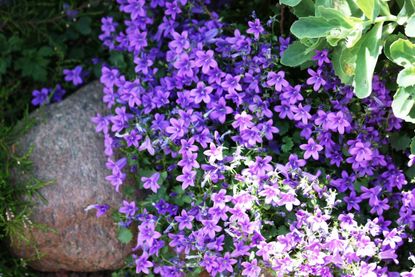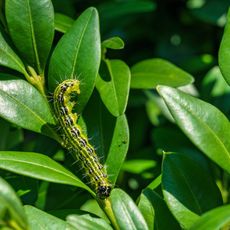False Rockcress Plants: Learn How To Grow Aubrieta Groundcover


Aubrieta (Aubrieta deltoidea) is one of the earliest bloomers in spring. Often part of a rock garden, Aubretia is also known as false rockcress. With its darling little purple flowers and dainty leaves, Aubrieta will scramble over rocks and other inorganic items, covering them with color and distracting the eye. Aubrieta groundcover is also remarkably drought tolerant once established and can handle the harsh heat of a full sun rockery. Read on for some tips on the care of Aubrieta and how to use this magical little plant in the garden.
Aubrieta Growing Conditions
Aubrieta is a perennial suited for USDA zones 4 to 8. This temperate to cool region plant can spread up to 24 inches (61 cm.) over time and forms lovely purple carpets of color in spring. It is non-invasive and self-sufficient for the most part. Learn how to grow Aubrieta in your landscape so you can enjoy its charm in your border, rockery, or even container garden. False rockcress plants prefer full sun and well-drained soil. The plant prefers sites that are rich in lime. These easy-care plants are also adapted to partial shade locations, but some blooms may be sacrificed. Aubrieta is a member of the mustard family, a notoriously tough group of plants. It is deer resistant and tolerant of drought once established. Once the full heat of summer is released, the plants tend to die back a bit and in fall much of the foliage will disappear in cooler climates. Aubrieta groundcover can tend to get a bit scraggly over time and responds well to shearing back after bloom or in fall.
How to Grow Aubrieta
Aubrieta grows well from seed. It is easy to establish and requires a minimum of water as the seedlings grow. Choose a sunny spot in the garden in early spring with well-draining soil or alternately start seeds indoors in flats six to eight weeks before planting outdoors. Remove any debris and till soil to a depth of 6 inches (15 cm.). Sow seeds on the surface of the soil. Water gently with a diffuser attachment to prevent drowning seeds and pushing them under too much soil. Keep the area moderately wet but not soggy. Once seedlings appear, keep weed pests from the area and thin plants to one every 10 inches (25 cm.). Over the spring, false rockcress plants will gradually spread out to cover the area in a thick carpet. Young plants may develop a few spotty flowers, but a full flush of blooms should not be expected until the following year.
Care of Aubrieta
These little plants couldn't be easier to manage. Cutting the plants back after bloom can discourage seeding and keep the plants compact and tight. Every one to three years dig up the plant and divide to prevent center die out and propagate more plants for free. Keep Aubrieta moderately moist especially during the growing season. False rockcress has few disease or insect pest issues. The most common problems occur where soil is clay or drainage is poor. Make sure you amend soil and check for percolation prior to planting them out. There are several cultivars available with flowers of red, lilac, and pink. These lovely plants are beautiful cascading over a wall or even a container. They tend to look a little sad in early spring, as some of the foliage will have dropped but quickly recover with warming temperatures and spring rain.
Gardening tips, videos, info and more delivered right to your inbox!
Sign up for the Gardening Know How newsletter today and receive a free download of our most popular eBook "How to Grow Delicious Tomatoes."

Bonnie Grant is a professional landscaper with a Certification in Urban Gardening. She has been gardening and writing for 15 years. A former professional chef, she has a passion for edible landscaping.
-
 Urban Composting Guide: How To Compost In The Middle Of The City
Urban Composting Guide: How To Compost In The Middle Of The CityUrban composting does not have to be daunting. You can compost in the city, and maybe even try some urban worm composting!
By Mary Ellen Ellis
-
 Shrub Diseases And Pests To Watch Out For
Shrub Diseases And Pests To Watch Out ForShrub diseases and pests can be challenging. Learn how to recognize and eradicate them before they can present a danger to your plants.
By Susan Albert